We have examined nearly 1000 images shortlisted for the Astronomy Photographer of the Year competition in the past seven years to find the best lenses for astrophotography.
Using this data, we recommend here the best budget and premium lenses for either Milky Way landscape astrophotography or deep-sky astrophotography, for Sony, Canon, and Nikon cameras.
Watch the video below or read on to see more analysis and for detailed product overviews.
What Makes the Best Lenses for Astrophotography?
So you’ve got your camera, tripod, and maybe a star tracker, and now you want to make sure you’ve got a lens to perform for astrophotography.
As with buying any astrophotography equipment, it’s important to do your research and get what’s right for you. Not doing so can mean wasted time and money, and nobody wants to be going out in the middle of the night to photograph the night sky without being confident that they have the right gear to do the job.
Having the right setup makes it much easier to capture great astrophotography images – whether it’s Milky Way landscapes or deep space objects – and lets you focus on the other aspects like location and timing so you can get it done quicker and easier.
Different Focal Lengths for Different Astronomy Objects
The best astrophotography lens for you depends on what you want to shoot:
- For Milky Way/starry landscape photography, you want a lens with a wide (short) focal length and a fast aperture.
- For deep space photography, you want a telephoto lens with a long focal length and fast aperture.
Let’s look at each of these in more detail.
Lenses for Milky Way Photography
There are two main things to look for in a lens to give you the best chance of getting fantastic shots of the Milky Way or starry skies above the Earth:
- a wide focal length, and
- a fast aperture.
Wide Focal Length
Firstly, the lens you use should be wide angle.
This means a short focal length as measured in millimeters, the lower the number the wider it is, and therefore the more sky you can capture.
It will depend on the type of camera you have but a wide-angle lens is generally regarded as:
- 35mm or below for a full-frame camera
- 24mm or below for an APS-C sensor camera
- 16mm or below for a micro 4/3 camera
To work out what focal lengths and lenses the most successful astrophotographers are using today we analyzed all the 130+ shortlisted images for the prestigious Astronomy Photographer of the Year competition.
From this information, we extracted just the data for the focal lengths used in the landscape astrophotography images and found that 14mm lenses are by far the most commonly and successfully used:
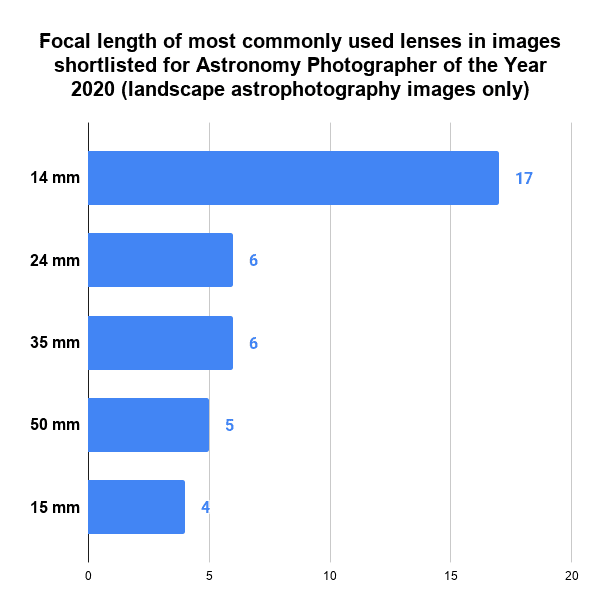
Note that virtually all of the cameras that these lenses were used with will have been full-frame DSLR or mirrorless models (see the camera data).
See What is the Best Focal Length for Astrophotography? for the full analysis.
So now we know what focal length we want, what about aperture?
Fast Aperture
The lens you use should have a fast aperture.
This is indicated (slightly confusingly) by a low f/number. For example:
- f/1.8 is a low f-number and a fast aperture
- f/4 is a high f-number and a (relatively) slow aperture
The aperture is the opening within the lens that governs how much light is collected in a single shot. The lower the number, the larger the aperture of the lens and the more light that it can collect for exposing the stars in the night sky.
A good lens for astrophotography will have an f/number rating of f/2.8 or lower.
In the Astronomy Photographer of the Year competition data we analyzed, the make and model of the lenses was not always shared, but the focal length and aperture were and it showed that the 14mm lenses used were models with either an f/1.8 or f/2.8 aperture.
Now, super sleuths that we are, this has enabled us to work out that this corresponds with two of the most popular lenses around for landscape astrophotography, namely the:
This is why we recommend these two as the best lenses for wide-angle astrophotography.
The other two most popular lenses were the:
- Tamron 15-30mm f/2.8 (for Canon, Nikon)
- A 24mm f/1.4 lens – there are Sigma, Sony, and Rokinon models that all have these specifications
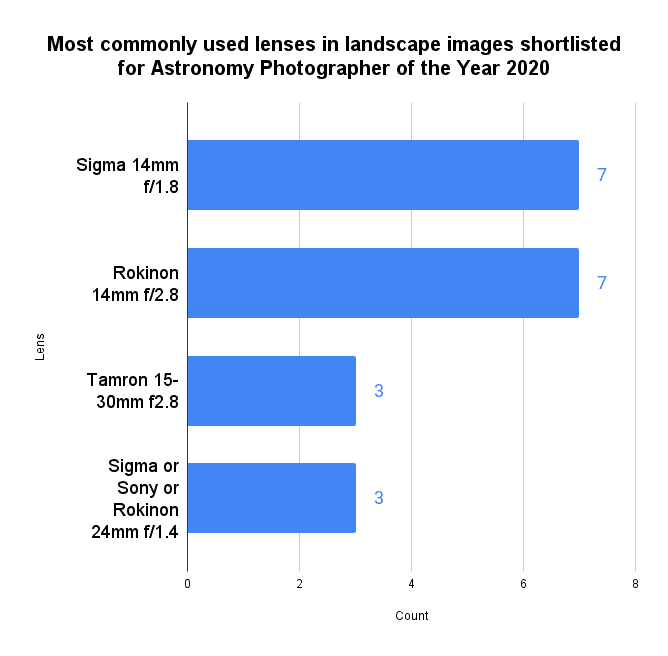
More details on each of these lenses can be found below.
Best Lenses for Milky Way Photography
Rokinon 14mm F2.8
Best Budget Milky Way Astrophotography Lens
The Rokinon 14mm f/2.8 lens is one of the most popular astrophotography lenses and the one that many people start with when they first want to have a go at photographing starry skies with their DSLR.
Our data above also shows that it is used by some of the most successful astrophotographers in 2024 and so it is not just a beginner’s lens.
It has the optimal wide focal length (14mm) and a fast aperture (f/2.8). What makes it a great starter option is that it is relatively cheap compared to other comparable lenses which makes it a perfect budget astrophotography lens.
It is compatible with full-frame and APS-C sensor cameras (with crop factor this would be an effective 21mm lens for APS-C cameras – see the FAQs below for an explanation of this).
Versions of the lens are available for Canon, Nikon, Sony, Pentax, and Fujifilm cameras.
One thing to note is that there are a few different versions of this lens which can be quite confusing:
- The Rokinon 14mm with and without a focus confirmation (AE) chip – you want the version with the chip so that it can communicate with your camera and be operated by it.
- The Rokinon 14mm with manual focus or autofocus (AF) – if you are getting it just for astrophotography then save some money and get the manual focus version, it’s all you will use for astro imaging. The autofocus would only be useful if you were planning to use it for other photography purposes.
- The original model and an updated (Series II) model – The main difference on the Series II version is that it has a function to allow you to lock the focus ring – this is a nice-to-have but not essential.
The links below are for the version with the AE chip, manual focus only, and without the locking functionality (just because it is usually cheaper without it). This is what we recommend as the perfect budget astrophotography lens, but you may prefer the slightly different versions.
Key specifications
- Focal length: 14mm
- Aperture: f/2.8
- Compatible mountings: Canon EF, Nikon F, Nikon Z, Sony E, Fujifilm X, Pentax K
- Sensor size compatibility: Full-frame, APS-C
- Lens weight: 1.2lbs (0.5kg)
Rokinon vs Samyang
Rokinon is a South Korean manufacturer that produces some great lenses. Confusingly, they also go by the name Samyang in different markets and this means you can sometimes find the same lenses under different names available to buy.
For example, the Samyang 14mm f/2.8 and Rokinon 14mm f/2.8 lenses can sometimes both be found for sale on the same markets at different prices, despite being the same lens.
One of the positives of this though is that you can hunt around for the best price on Amazon, KEH Camera, or your chosen retailer by searching with different names.
Sigma 14mm F1.8 Art
Best Milky Way Astrophotography Lens
The Sigma 14mm f/1.8 Art lens is a more premium 14mm lens and the best overall if you have the budget.
The key difference from the Rokinon lens covered above is a much faster aperture of f/1.8. This enables it to capture more light from the night sky and results in improved astronomy images.
The only downsides are that it usually costs more (but check live prices with the links below) and it weighs more (2.6 lbs vs. 1.2 lbs for the Rokinon lens). This is a factor when carrying the lens to the location from where you will shoot, and could also be an issue if using a star tracker as they all have a specific maximum weight they can take to work effectively.
It comes with autofocus as standard but can be used in manual focus mode for astrophotography. Versions are available for Canon, Nikon, Sony, Leica, and Panasonic cameras.
It’s tailored for full-frame cameras but will work on crop sensor (APS-C) cameras where it would have an effective focal length of 21mm.
Key specifications
- Focal length: 14mm
- Aperture: f/1.8
- Compatible mountings: Canon, Nikon, Sony E, Leica/Panasonic L-Mount
- Sensor size compatibility: Full-frame, APS-C
- Lens weight: 2.6lbs (1.2kg)
Tamron 15-30mm f/2.8
Best Budget Zoom Lens for Astrophotography
This Tamron lens is perfect for night sky photography and well-loved by experienced astrophotographers. You can see the results of its use for capturing the Milky Way in our profile of the work of Ivan Slade.
The zoom functionality obviously gives you a bit more flexibility compared to a fixed (prime) focal length like the lenses above. This means you can adjust the width for a particular shot and also makes the lens more versatile for use beyond astrophotography.
It is designed for full-frame cameras but can also be used with crop sensor cameras (where it would be equivalent to a 22-45mm lens).
This lens is available for Canon and Nikon cameras only, although a 17-28mm f/2.8 version is available for Sony cameras.
Key specifications:
- Focal length: 15-30mm
- Aperture: f/2.8
- Compatible mountings: Canon EF, Nikon F, Sony E
- Sensor size compatibility: Full-frame, APS-C
- Lens weight: 2.4lbs (1kg)
Nikon AF-S NIKKOR 14-24mm f/2.8
Best Astrophotography Lens for Nikon Z Mount Cameras
Lastly, the Nikon/Nikkor 14-24mm f/2.8 is an extremely popular wide-angle lens for astrophotography.
The original lens has been on the market since 2003, but a new version for Nikon Z mirrorless cameras was released in 2020. The Rokinon 14mm f/2.8 does have a Nikon Z compatible version, but options for mirrorless cameras are currently slightly more limited (although expect that to change in the future).
The use of this lens for capturing the Milky Way can be seen in the work of Micheal Ver Sprill.
It gives you the optimal focal length (14mm) but also the flexibility of a zoom lens to adjust this up to 24mm. Its aperture is also within the optimal range for night sky imaging at f/2.8.
Whilst it is a Nikon lens, you can use an adapter so that it fits with Canon and other camera bodies.
Key specifications
- Focal length: 14-24mm
- Aperture: f/2.8
- Compatible mountings: Nikon F, Nikon Z
- Sensor size compatibility: Full-frame, APS-C
- Lens weight: 2.4lbs (1kg)
Lenses for Deep Sky Astrophotography
To take photos of deep sky objects like galaxies and nebulae you are going to need a different lens from what you would use for landscape astrophotography.
Specifically, you are going to need a lens with a long focal length to allow you to zoom into these far-off objects.
Long Focal Length
Whereas for Milky Way landscape astrophotography, you need a wide-angle lens to capture as much of the sky as possible, with deep sky astrophotography you want a narrow lens with a long focal length.
This will allow you to focus on an object that is effectively much smaller in the night sky, as compared to the Milky Way which spans across the whole sky above Earth.
Ideally, the minimum focal length to go for would be 100mm, but the higher you go, the more you will be able to zoom right into these objects and so 200mm to 600mm is a good range.
Aperture
Again, fast aperture is important as it helps gather light from faint objects that are very far away.
You can actually get away with slower aperture lenses as for deep sky imaging you will need to be tracking with a star tracker or astrophotography mount in order to get very long exposures to gather enough light (or lots of short exposures that will be stacked in post-processing software).
With Milky Way photography you can also use tracking for longer exposures, but if you are under dark skies and have the right camera and lens setup then it is more than possible to capture a great image with one untracked image. The same will not be true for deep-sky imaging.
Best Lenses for Deep Sky Astrophotography
Rokinon 135mm f/2.0
Best Budget Deep Sky Astrophotography Lens

A greater starter telephoto lens for deep sky imaging is this Rokinon 135mm model.
It has a fast aperture (f/2.0), it is light and will work well with a star tracker, and it is relatively cheap, especially when compared to some premium telephoto lenses.
The limitation is that it is relatively short compared to some 200-600mm lenses, but it can still work for photographing those far-off messier objects when tracking.
Key specifications
- Focal length: 135mm
- Aperture: f/2.0
- Compatible mountings: Nikon F, Canon EF, Sony E, Sony A, Fuji X, Pentax KAF, Samsung NX, Micro 4/3
- Sensor size compatibility: Full-frame, APS-C, Micro Four Thirds
- Lens weight: 1.9lbs (0.9kg)
Tamron SP 70-200mm f/2.8 G2

This 70-200mm lens from Tamron is a great option for deep sky imaging with a DLSR or mirrorless camera.
Not only does it give you a long focal length of up to 200mm, but also it boasts a fast aperture of f/2.8 to give you that much-needed light-gathering capability.
The lens is available for Canon and Nikon camera bodies, with a close relative (70-180mm) available for Sony models.
Key specifications
- Focal length: 70-200mm
- Aperture: f/2.8
- Compatible mountings: Nikon F, Canon EF, Sony E
- Sensor size compatibility: Full-frame, APS-C
- Lens weight: 3.3lbs (1.5kg)
Tamron SP 150-600mm F/5-6.3
Best Value Long Focal Length Lens for Deep Sky Astrophotography
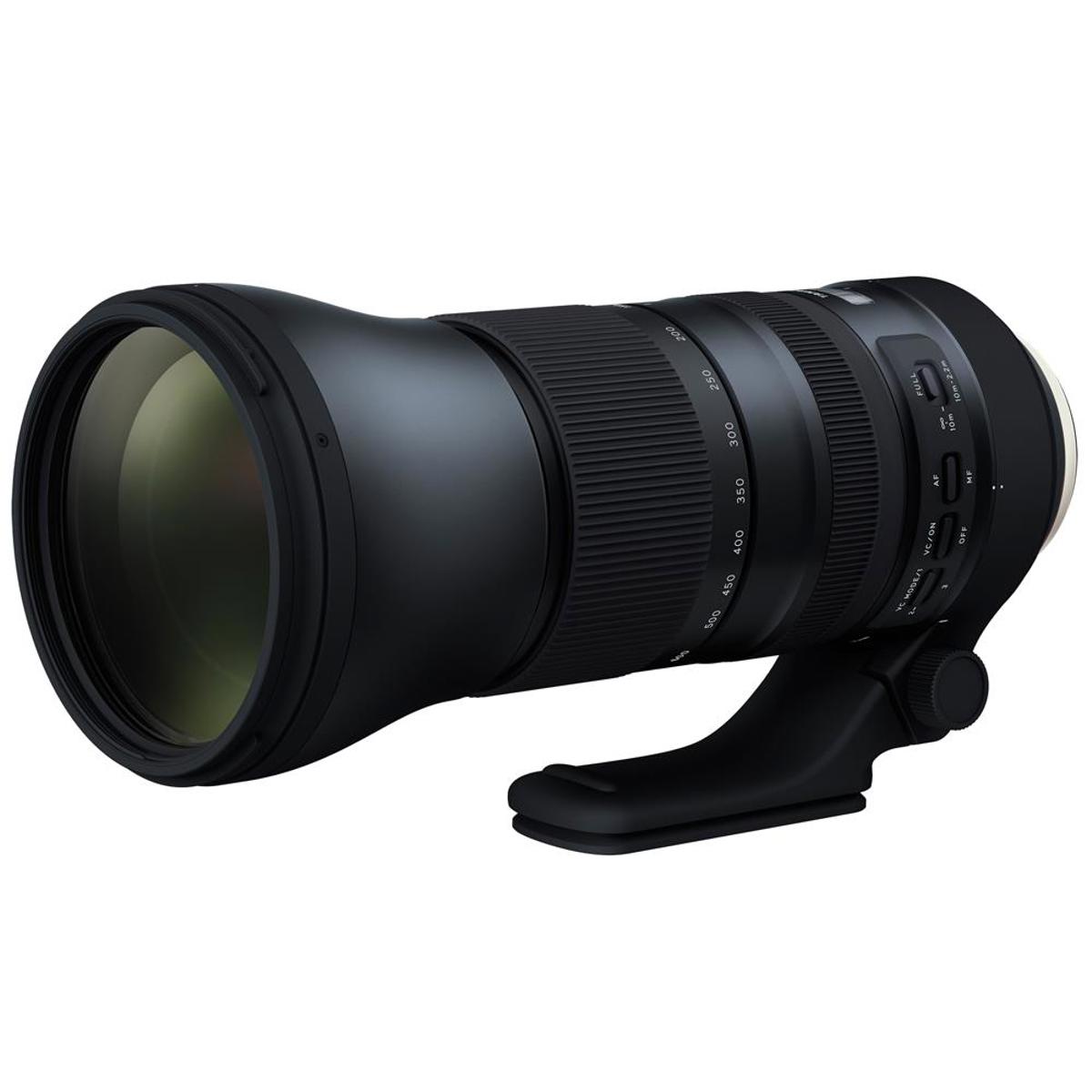
For a really long focal length, the Tamron 150-600mm f/5-6.3 is a great value lens for deep sky astrophotography when used with a tracking mount.
Originally released in 2013, it was updated to the “G2” version in 2016. It can be bought for Nikon, Canon, and Sony camera bodies.
The focal length range of 150-600mm is extremely long and perfect for zooming into deep sky objects. It will need to be used with a star tracker and sturdy tripod to be effective, especially due to the relatively slow aperture.
As with many telephoto lenses, it comes with a mount for attaching directly to a tripod as it is so heavy (i.e. attaching the camera to the tripod with this lens would be imbalanced).
There are other great lenses with similar focal lengths, but we are recommending this Tamron model as it provides a great balance for performance to price.
Key specifications
- Focal length: 150-600mm
- Aperture: f/5-6.3
- Compatible mountings: Canon EF, Nikon F, Sony E
- Sensor size compatibility: Full-frame, APS-C
- Lens weight: 4.3lbs (1.9kg)
Best Lens for Astrophotography FAQs
What focal length is best for astrophotography?
It depends on what you are shooting:
- If you want to capture landscape astrophotography shots of starry skies or Milky Way above the Earth, then you want a wide-angle lens with a short focal length. Our research shows that 14mm is optimal when using a full-frame camera.
- If you want to capture the moon, planets, or deep sky objects like galaxies, then you want a telephoto lens with a long focal length. This could be anything from 100mm to 600mm.
For more on this, see our article What is the Best Focal Length for Astrophotography?
What is the best lens for photographing the planets?
For planetary photography, you want a telephoto lens with a long focal length like 100mm to 600mm.
Unlike with other types of astrophotography, a fast aperture is not as important as these objects are relatively much closer and brighter.
What is the best lens for photographing the moon?
Similar to photographing the planets, you need a long focal length lens to capture the moon. The longer the better, as it will enable you to zoom in further.
Aperture is not important, since the moon is a bright object in the sky.
Is a 50mm lens good for astrophotography?
Many photographers have a prime 50mm lens or 35mm lens in their kit bag as they are great versatile lenses for many types of photography.
The most common of these are fast apertures of f/1.8 so they can definitely be used for astrophotography. See these models:
The problem is that the focal length isn’t really ideal for the different types of astrophotography, for example:
- 50mm is too narrow to capture a wide sky for landscape astrophotography
- 50mm is not long enough for deep sky or planetary astrophotography
Having said that, you can see examples of successful astronomy imaging with ‘nifty fifty’ lenses and one way to make it work for landscape astrophotography is to use it for taking a number of photos and stitching them together as a panorama (although this is a fairly advanced technique).
The advantage is that these lenses are cheap and versatile, so if you have one, or are thinking of getting one, there is nothing to stop you from experimenting with it for astrophotography.
Can I use a telescope instead of a lens for deep space astrophotography?
Yes, you can. The closest alternative to long focal length lenses are small telescopes that are dedicated to astrophotography called apochromatic refractors.
In many ways these are similar to long focal length camera lenses and are not what you might traditionally imagine for a telescope – for example, you cannot look through them for observing the sky. They are solely for photography and you can attach regular DSLR or mirrorless cameras with the help of an adapter.
Popular examples of such telescopes are:
These small telescopes are generally available in a similar price bracket to telephoto lenses so they are worth considering for deep sky astrophotography. However, they are dedicated to this pursuit and so will not be useful for any other types of photography.
See our article on the best telescopes for astrophotography for more on this.
How do I calculate focal length for APS-C vs. full frame cameras?
The focal length given for lenses is only what it says it is if you are using a full-frame sensor camera. If you are using a camera with a cropped sensor (APS-C, Micro four-thirds) then this length is reduced.
For example, a 14mm lens on a full-frame camera is 14mm. On an APS-C sensor camera it will effectively work as a 21mm lens.
The easy way to calculate this is to times the focal length by 1.5 (so 14mm x 1.5 = 21mm)
With regards to Milky Way and landscape astrophotography this is something to be careful of when using a crop sensor camera as you want the wide angle to capture a large portion of the sky.
This means that with a full-frame camera you could comfortably use a 24mm lens as wide-angle, but with an APS-C sensor camera this would effectively be 36mm, which may be too narrow (depending on the shot).
On the other hand, if shooting deep sky a crop sensor lens can effectively increase your focal length and allow you to zoom into those objects better. For example, a 200mm lens on an APS-C camera would be 300mm. Therefore a crop sensor camera with a long lens and a tracker/mount can be a good deep-sky setup and allow you to use a cheaper camera.
You can read more about this in our article, Full Frame vs APS-C: What’s Best for Astrophotography?.
What are the 500 rule and NPF rule?
The 500 rule is a way of calculating the longest exposure time you can shoot with a particular lens before you get star trails.
The formula is: 500 / focal length of lens (mm) = maximum exposure time (secs)
You can also use our free 500 Rule Calculator.
For example, with a 14mm lens it would be 500/14 = 35.7. Therefore, with this rule, you could plan to take one shot of the night sky for anything up to 36 seconds and have sharp stars.
However, the 500 rule has become a bit out of date and doesn’t really work very well for modern cameras. This is why sometimes you might also see the 400 rule or 600 rule mentioned – they are variations of the same that give just a rough indicator for the shutter speed you need to use.
A better formula today is the NPF rule. NPF stands for
- N = aperture (it was originally conceived in French and so this may account for why it is ‘N’ and not ‘A’)
- P = pixel density
- F = focal length
The formula is: (35 x lens aperture (mm) + 30 x pixel pitch (mm)) ÷ lens focal length = maximum exposure time (secs)
As you can see, you need to find out your camera’s pixel pitch to calculate this. Pixel pitch is the width of the sensor and you might have to do some googling to work it out.
We do have a free NPF Rule Calculator that you can use.
Alternatively, you can use an app like Photopills that has an in-built calculator for both the 500 rule and the NPF rule.
In the Spot Stars section of the app, you enter your camera model and lens focal length and aperture and it will give you the result. Here is the result for a Nikon D750 and a Rokinon 14mm f/2.8 lens:
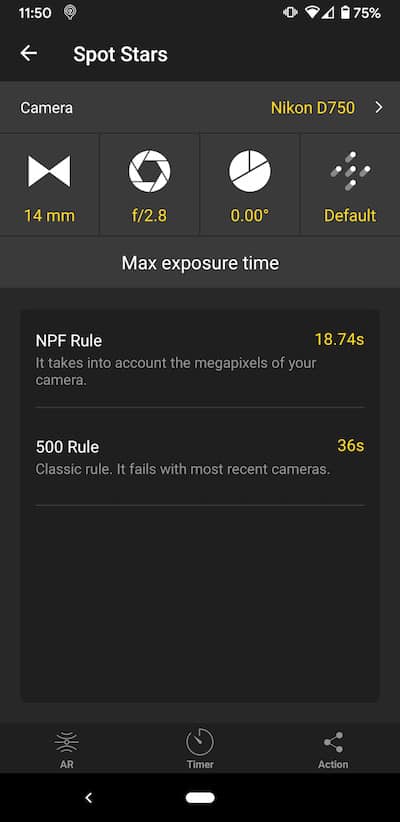
As you can see, the results are quite far apart:
- For the 500 rule, it says 36 seconds,
- For the NPF rule it says half that at 18 seconds.
Since we know that the NPF rule is more accurate, that is what we will use. It shows how far off the 500 rule is nowadays and would leave you with a lot of star trailing in this case.
Conclusion: What are the best lenses for astrophotography?
Overall then:
- If you are looking to get a lens for Milky Way/landscape astrophotography then the Rokinon 14mm f/2.8 is a great option and often then one that most people go for when they want to jump into astrophotography with their DSLR camera.
- If you have the budget then the Sigma Art 14mm f/1.8 is a better lens but costs more.
- If you are looking for a lens for deep sky astrophotography then the Rokinon 135mm f/2.0 is a great low budget option.
- If you want more focal length then consider one of the Tamron lenses covered above or go for a small apochromatic refractor telescope if you really want to get into deep sky astrophotography.
We hope this overview helps you make the decision of the best astrophotography lens for you.
Please let us know in the comments below if you agree or disagree, or have any questions.


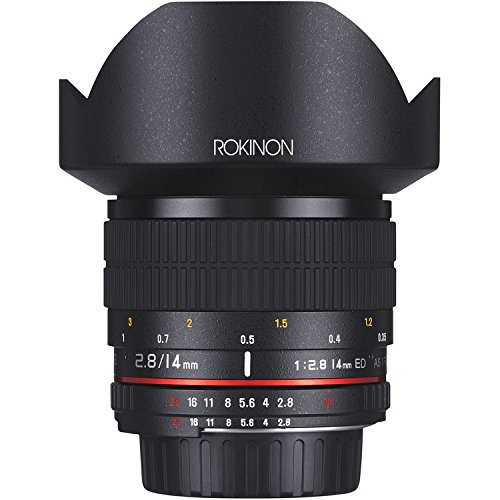




Hi,
I was wondering if you could help me. I have just purchased a Canon 5D mk.iv after getting a great deal(-30%) and wanting to upgrade to my first full-frame sensor. My plan originally was to take landscape and astro-landscape shots whilst traveling, originally i was set on buying 2 lenses to cover both themes of shooting and my choices were:
Carl Zeiss 21mm f/2.8 Distagon for Landscape
Rokinon 24mm F/1.4 for Astro-landscape
but i am now thinking the Rokinon has too-narrow a focal length and i should get something more wide to really capture the landscape at night. Is it worth getting both lenses though? Or is there a lens that will cover both these subjects without sacrificing quality in each shooting theme or am i better off keeping the distagon and buying a astro-landscape specific lens? I want to shoot both themes but i am not sure what to buy in terms of a astro-specific lens and even more so now after hearing that many Rokinon 24mm f/1.4 are defective and get returned due to imperfections.
What are my choices in your humble opinion? I have around $2000 for 2 lenses and the majority of that was going to go towards the Distagon(know source i can get for $1100) and the remaining would be for my astro-specific lens although i may be tempted to spend more on something truly worth it . Please can you advise?
Many Thanks in advance!
John
Hi John,
It’s hard to say what is right for any one person but I think that with a full frame camera the 24mm lens is certainly wide enough.
I would say though that given both of these lenses you are considering are good, fast, wide lenses, it might be best just to get one and try it for both landscape and astro and see what results you can get with it, rather than getting the two lenses at the same time. You might then find it gives you all you need, or if not you’ll learn to push it to its limits and then be in a better place if you decide you want to invest further.
Good luck!
Anthony
what about the Rokinon 12mm F2.0 lens?
Yep, that’s a perfect lens that ticks all the boxes for astrophotography. 12mm is wide and f/2 is plenty fast.
Hi,
Just wondering how these two compare?
Samyang AF 14mm f/2.8 Full Frame Sony E-mount
Rokinon AF 14mm f/2.8 Full Frame Sony E-mount
I think these might be the same lens – Rokinon & Samyang (and Bower) are the same company but they offer the same lenses under different brand names in different markets.
On Amazon they appear to be identical in specifications and description:
– Rokinon 14mm f/2.8 – https://amzn.to/2pLl7tM
– Samyang 14mm f/2.8 – https://amzn.to/2IaDgaV
The Rokinon lens is available slightly cheaper and so I would just judge it on that.
I have a 12 inch f/4 Newtonian reflector and I’m looking for a wide angle lens that works with a ccd such as Neximage 5 or Skyris 236M for Astrophotography. Using prime focus is fine for planetary work but no good for wide sky, deep sky and constellation shots.
Will these lenses work and what adapters do I need such as T ring etc.
What about the Samyang 14mm XP lens?
Hi Rosie, that’s a good wide angle lens that would work for milky way photography.
Thank you for the wonderful article! I have Sony A6000 camera. If I was to choose between:
Rokinon FE14M-S 14mm F2.8 Ultra Wide Lens
Rokinon RK12M-E 12mm F2.0 NCS CS Ultra Wide Angle
Which one should I go for? My understanding is that the smaller the aperture, the better, so is F2.0 the better choice? Is there any difference between 12 and 14 mm then?
Hi Roman, I believe Rokinon 12mm F2.0 NCS CS Ultra Wide Angle Lens would be the best for your Sony A6000 camera as this lens is tailored for APS-C crop sensor cameras (like the A6000).
The Rokinon FE14M-S 14mm F2.8 Ultra Wide Fixed Lens is intended for fullframe cameras, although is compatible for APS-C sensor cameras and should work with it.
Other than that, the differences are minimal – F2.0 is slightly faster than F2.8 and 12mm is slightly wider than 14mm.
Hope that helps!
Hi , my name is amin .instagram page: nightsky_bahmani
Sigma art85 ia good for astrophotography?
Hi Amin, so the Sigma Art 85 at 85 mm is not a wide-angle lens so won’t be good for capturing images of the Milky Way over the earth etc. However, it is a good, fast lens at f/1.4 and so would still be great for many other kinds of astrophotography and I’m sure you could get great results with it. It just depends on what you really want to shoot. Good luck!
Any thoughts on Nikon 135mm f2 DC ?
Yes, you could definitely use that for deep sky photography, just like the Rokinon 135m f/2 above.
Have you, or anyone you know, ever tried the Tamron 1.4X teleconverter on the Tamron 150-600 G2 and how did it do?
Hi Patrick, sorry I have no experience with this but from a quick scan it looks like a good tool for increasing your focal length. Best of luck!
Thanks for the quick response. 🙂
You’re welcome!
Awesome lens presentation. Thank you !..
Thanks Alain!
Is a fisheye lens good for astrophotography?
Such like NIKKOR 16mm f2.8 Af-D fisheye.
You can use them and be creative, but most don’t like the distortion around the edges that you get with fisheye lenses